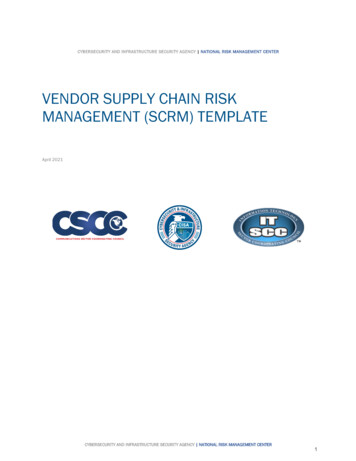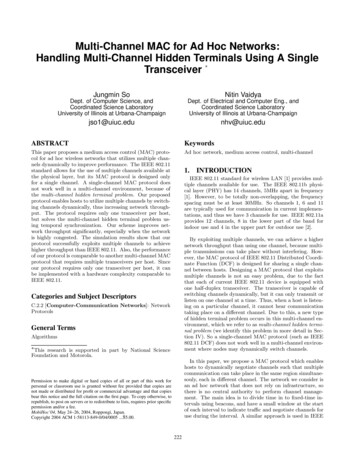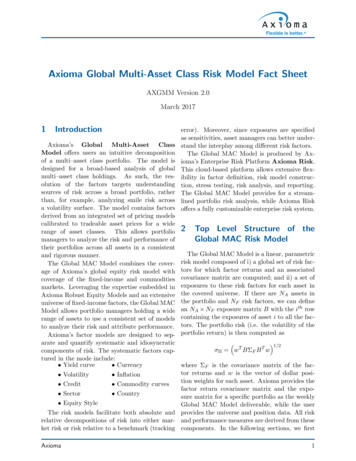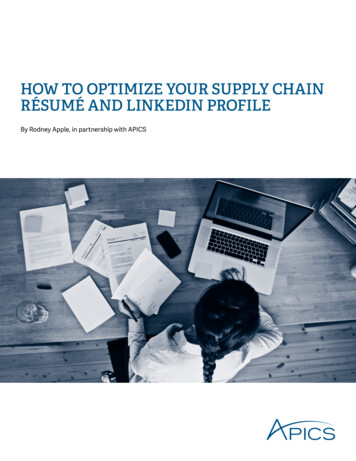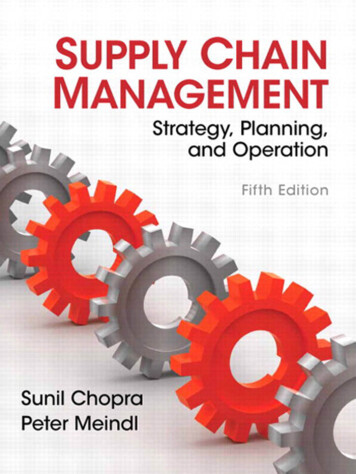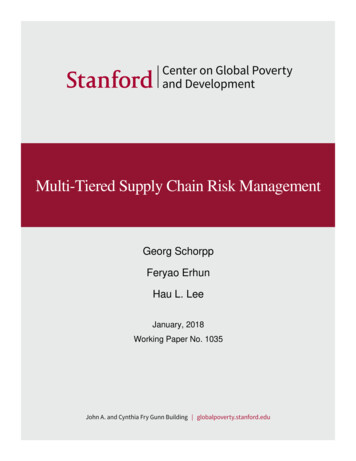
Transcription
Multi-Tiered Supply Chain Risk ManagementGeorg SchorppFeryao ErhunHau L. LeeJanuary, 2018Working Paper No. 1035
Multi-Tiered Supply Chain Risk ManagementGeorg SchorppEnd-to-End Analytics, Palo Alto, CA 94303, georg@e2eanalytics.comFeryal ErhunCambridge Judge Business School, University of Cambridge, Cambridge CB2 1AG, UK, f.erhun@jbs.cam.ac.ukHau L. LeeGraduate School of Business, Stanford University, Stanford, CA 94305, haulee@stanford.eduWe study contracting for a three-tier supply chain consisting of a buyer, a supplier, and a sub-supplier wheredisruptions of random length occur at the sub-supplier. As is common in supply chains, the buyer has a directrelationship with the supplier but not the sub-supplier; that is, the buyer has limited supply chain visibility.Both the supplier and the sub-supplier can reserve emergency capacity proactively to protect the supplychain from a disruption. We study how the buyer and the supplier can guarantee that the correct level ofemergency capacity is reserved. Due to two types of inefficiencies—a special form of double marginalizationand the substitution effect—the supply chain is misaligned in its decentralized form, leading to either underor over-reservation of emergency capacity by the sub-supplier depending on the cost structure of the supplychain. The lack of visibility prevents the buyer from directly contracting with the sub-supplier to eliminatethese inefficiencies. Yet, he can coordinate the supply chain through cascading: i.e., contracting with thesupplier (using a value-based carrot-and-stick contract), who in turn contracts with the sub-supplier (usinga cost-based carrot-and-stick or two-level wholesale price contract, depending on the cost structure of thesupply chain). Although the sub-supplier is the source of limited visibility in the supply chain and is theparty with private information, the supplier is the one that benefits from this limited visibility and is theparty that receives information rent from the buyer.Key words : multi-tier supply chain; disruption risk; asymmetric information; contract designHistory : January 20181.IntroductionThe 2011 Tohoku earthquake and the following tsunami had devastating social and environmentalconsequences in Japan ranging from over 15,000 deaths to nuclear accidents (NPA 2017). At thetime, its total economic impact was estimated in the order of 200-300 billion or roughly 4.5% ofJapan’s GDP (Ujikane 2011). As Japan houses many semiconductor and high-technology companiesand their supply chains, companies such as Hitachi, Sony, Toshiba, and Texas Instruments sufferedfrom supply chain disruptions. Texas Instruments, for example, lost approximately 10% of theirannual revenue due to a 6-month plant closure (Nanto et al. 2011). The damage was not limited tothe semiconductor and high-technology industries. When Toyota resumed production two weeks1Electronic copy available at: https://ssrn.com/abstract 3117626
2Schorpp, Erhun, and Lee: Multi-Tiered Supply Chain Risk Managementafter the earthquake and tsunami, almost two-thirds of its suppliers were still disrupted (Forbes2011). At the time, analysts projected that as many as five million cars worldwide would not bebuilt in 2011 due to the earthquake and tsunami related disruptions in automobile supply chains(Bunkley and Jolly 2011).Intel Corporation was yet another company that was affected by the Tohoku earthquake.Although Intel does not have any manufacturing facilities in Japan, a significant part of suppliersand sub-suppliers for Intel’s material supply chain (i.e., part of Intel’s value network that concernswith the sourcing of raw materials and components required for production) are located in Japan.Historically, Intel had strong business continuity plans for its own manufacturing facilities and inmany cases for its Tier 1 suppliers. However, Intel’s visibility and control over the upstream partsof the supply chain (which was affected highly from the earthquake) was limited, opening Intel upto major disruption risks and supply chain management challenges. This paper is motivated bythese challenges and is a part of a research collaboration developed in partnership with Intel.1.1.Risk Management Challenges in Intel’s Material Supply ChainRaw materials and components in Intel’s material supply chain can be grouped under four categories: micro-contamination-control equipment, high-density substrates, multilayer ceramic capacitors, and litho-chemicals (Figure 1). Next, we discuss risk factors in these four categories thatinform our stylized model (Table 1).Within these four categories, Intel sources from over 16,000 suppliers spanning more than 100countries (Intel 2013), leading to a complex multi-tiered supply network. Due to this complexity, itis difficult for Intel to control their material supply chain beyond the company’s Tier 1 supply base,which already includes about 250 suppliers. Therefore, Intel often delegates their sourcing either tothird parties (such as two specialized distributors that source 4,000 micro-contamination-controlequipment from 400 sub-suppliers (Figure 1(a))) or to Tier 1 suppliers. Consequently, Intel haslimited control and visibility over these sub-suppliers.Strict intellectual property (IP) regulations are another main reason for lack of visibility inIntel’s supply chain. For example, Intel’s high-density-substrate (Figure 1(b)) and litho-chemicals(Figure 1(d)) suppliers use materials that involve highly protected IP sourced from their subsuppliers, which thus must remain unknown. Although Intel is well connected with Tier 1 and insome cases Tier 2 suppliers of their high-density-substrate supply chain, they generally have limitedinformation about their sub-supplier base beyond a certain point.In addition to the challenges caused by limited control and visibility over sub-suppliers, Intel’sability to react to a disruption is also limited due to high product specificity and strict quality standards required to manufacture Intel’s products. Therefore, proactive risk management strategiesElectronic copy available at: https://ssrn.com/abstract 3117626
3Schorpp, Erhun, and Lee: Multi-Tiered Supply Chain Risk nvisibilityBuyerIPprotection4,000 products from400 sub-suppliersNon-substitutable(b) High-density substrates(a) Micro-contamination controlIntel has smallmarket GeographicalconcentrationTier 1 MultisourcingTier 2 SinglesourcingGeographicalconcentration(c) Multilayer ceramic capacitorsFigure 1Well connectedwith Tier 1 and 2(d) Litho-chemicalsDifferent Risk Factors in Intel’s Material Supply Chain. In addition to the control and visibility issues(subfigures (a) and (b)), Intel faces additional risk factors, such as geographical concentration of supplybase (subfigures (c) and (d)) and limited bargaining power (subfigure (c)).are key to Intel’s success.In this paper, we focus on supply chains with limited visibility beyond Tier 1 and with highproduct specificity1 using a stylized three-tier supply chain consisting of a buyer, a Tier 1 supplier,1There are other risk factors for Intel’s material supply chain. For example, most multi-layer ceramic capacitorssuppliers (Figure 1(c)) are geographically concentrated in Japan, increasing supply risk for Intel.Table 1The risk factors in Intel’s material supply chain and how they translate to our model.Real WorldObservationFigure 1Disruptionsa, b, c, dIntellectualPropertyb, dProductSpecificitySupply Chain ChallengeModelSub-suppliers tend to beunder-preparedDisruption of random lengthoccurs at Tier 2Invisibility aggravates supplychain coordination3 players; limited visibilitya, b, c, dShort notice diversification is notpossiblePeriodic model wherediversification has to be plannedupfront via emergency capacityProductVarietyaDiversification is not practical forthe buyer since sourcing isalready delegatedDelegation to supplierGeographicConcentrationc, dDiversification is not effective forthe buyer since protection is notguaranteed because of geographicconcentrationDelegation to supplierSmall MarketSharecDiversification is not economicalfor the buyerDelegation to supplier
4Schorpp, Erhun, and Lee: Multi-Tiered Supply Chain Risk Managementand a Tier 2 sub-supplier, who may suffer disruptions of random length. Although this stylizedmodel does not capture any one of the categories in Intel’s material supply chain, it does capturethe underlying risk factors that these categories share (Table 1). We study two questions: (1) Whatis the optimal strategy for reserving emergency capacity at the supply base when the sup-supplierfaces a disruption risk? What types of contracts can mitigate incentive misalignment between thesupplier and the sub-supplier in this setting? (2) How can the buyer incentivize the supply basewhen he has limited information regarding the capacity reservation costs?Analyzing the supplier and the sub-supplier first, we show that, due to two types ofinefficiencies—a special form of double marginalization and the substitution effect—the supplychain is misaligned in its decentralized form, leading to either under- or over-reservation of emergency capacity by the sub-supplier depending on the cost structure of the supply chain. Forunder-reservation, we show that a cost-based carrot-and-stick contract can achieve incentivecompatible supply chain coordination but neither can penalties (e.g., Reuters 2010) nor subsidies(e.g., Babich 2010) alone. For over-reservation, a two-level wholesale price contract can achieveincentive-compatible supply chain coordination. Although the lack of visibility prevents the buyerfrom directly contracting with the sub-supplier to eliminate these inefficiencies, we show that thebuyer can incentivize the supply chain through cascading: i.e., contracting with the supplier usinga value-based carrot-and-stick contract, who in turn contracts with the sub-supplier using theproposed cost-based carrot-and-stick or two-level wholesale price contract depending on the coststructure of the supply chain. As such, an incentive-compatible supply chain coordination can beachieved. Although the sub-supplier is invisible and holds the private information, the supplier isthe one who obtains information rent. Thus, the supplier benefits from a certain degree of invisibility in the supply chain.1.2.Literature ReviewSupply chain disruptions and risk management have been rigorously studied in operations management literature in recent years. We refer the reader to Snyder et al. (2016) for a review ondisruptions and Tang (2006) for a review on supply chain risk management.Early research on supply uncertainty focuses mainly on frequently occurring short-term interruptions such as machine breakdowns or short term unavailability of a supplier and study differentforms of disruptions at a single firm distinguishing between random capacity (Ciarallo et al. 1994,Erdem and Özekici 2002), random disruption (Parlar and Perry 1996, Gürler and Parlar 1997,Moinzadeh and Aggarwal 1997, Arreola-Risa and DeCroix 1998), and random yield (Parlar andWang 1993, Yano and Lee 1995, Agrawal and Nahmias 1997). More recently, the supply chain
Schorpp, Erhun, and Lee: Multi-Tiered Supply Chain Risk Management5aspect of disruptions is captured, and inventory (Tomlin 2006), diversification (Babich et al. 2007),supplier improvement (Wang et al. 2010), contracting (Chao et al. 2009), and the value of information on disruption risk (Tomlin 2009) are considered as effective risk management strategies. Ourfocus on limited supply chain visibility and high product specificity in a multi-tier supply chain setour research apart from the existing literature on supply chain disruptions and risk management.In recent years, the operations management literature started to study multi-tiered supply chains.One stream of this literature investigates supply chain hierarchies—delegation versus control formulti-tiered supply chains (Kayış et al. 2013, Huang et al. 2017). This stream implicitly assumesthat the sub-supplier is visible to the buyer; i.e., the buyer has the option of controlling the supplieror the sub-supplier. Besides the focus on disruptions, our model is different from the papers in thisstream in that the buyer does not know the sub-supplier. Another stream of multi-tiered supplychains research considers supply network formation and typology under disruptions (Bakshi andMohan 2017, Ang et al. 2017). Our focus on mechanism design and cascading adds to this stream.The remainder of this paper is organized as follows. We describe our model and study threebenchmark cases in Section 2. We tackle our first research question and analyze how the upstreamsupply chain can be coordinated in Section 3. We then focus on our second research question andstudy how cascading can be used in the multi-tier case in Section 4. In Section 5, we conclude ourpaper with a discussion on several risk management strategies for Intel’s material supply chainbased on our analysis and observations. The details of the analysis for the benchmark cases arerelegated to Appendix A. All proofs appear in Appendix B. We use x to represent max{0, x}.2.Model Description and Benchmark AnalysisIn this section, we describe our model and assumptions, and provide three benchmark cases.2.1.ModelWe study a stylized three-tier supply chain consisting of a buyer, a Tier 1 supplier, and a Tier 2sub-supplier where disruptions of random length T occur at Tier 2 (Figure 2). To protect the supplychain against a disruption, the supplier and the sub-supplier can proactively reserve emergencycapacity t1 and t2 , respectively. We assume that when there are no disruptions, demand is alwayssatisfied. The emergency sources, which are perfectly reliable, are used as a contingency onlywhen the supply at Tier 2 is disrupted. The reliability assumption is equivalent to assuming thatdisruptions at the sub-supplier and emergency sources never occur at the same time. Wagneret al. (2009) provide empirical evidence for positively correlated risk in the automobile industry,which is similar to what we observed in interviews with Intel supply chain managers about theirgeographically concentrated semiconductor supply chains. For example, three out of four multilayer
6Schorpp, Erhun, and Lee: Multi-Tiered Supply Chain Risk Managementdisruption lengthTproduction costcSub-supplier2wholesale pricevSupplierwholesale pricew1reservation cost k2,emergency cost e2Buyer0retail pricepdemand Dreservation cost k1,emergency cost e1E2Tier 2emergencysourceE1Tier 1emergencysourcet2Tier 2emergencycapacityt1Tier 1emergencycapacityvisiblevisibleinvisibleFigure 2Three-Player Two-Emergency-Source Supply Chain. The supplier and the sub-supplier decide how muchemergency capacity to reserve (t1 and t2 ) from their respective sources prior to the disruption. Thebuyer and the supplier design contracts (based on penalties and subsidies, or quantity discounts) toguarantee that the correct level of emergency capacity is reserved in the supply base.ceramic capacitors suppliers (Figure 1(c)) are located in Japan. Thus, the reliability assumptionrequires enough independence between sources such as through geographical diversification; e.g.,emergency sources may correspond to different locations of the sub-supplier.We assume the disruption length T to be a random variable with distribution F (T ) and densityf (T ), and with finite mean and variance. We model rare but disruptive events such as earthquakesor floods. Although the supply network of a large corporation, which combines multiple supplychains, may be disrupted frequently as noted by Snyder et al. (2016), we limit the number ofdisruptions in the planning horizon to one in order to represent the infrequency of disruptions for agiven supply chain. Such single period models are common in the supply chain disruption literature(e.g., Dada et al. (2007), Federgruen and Yang (2008)).Since our focus is on supply uncertainty, we assume demand D to be deterministic and constant,which is a common assumption in the literature on supply disruption (e.g., Parlar and Perry (1996),Swinney and Netessine (2009)). Since we assume demand and capacity to be deterministic, werepresent all parameters in units of time, since the only uncertainty in the system is the length ofthe disruption. Without loss of generality, we set D 1 and normalize all parameters accordingly.We denote the production cost as c and the retail price as p. The sub-supplier sells to the supplierat wholesale price v, and the supplier sells to the buyer at wholesale price w. We assume that
Schorpp, Erhun, and Lee: Multi-Tiered Supply Chain Risk Management7c v w p so that the supply chain is profitable for all players. The supplier’s cost for reservingemergency capacity is k1 and the sub-supplier’s is k2 , and emergency capacity can only be used forthe length of the disruption at an additional cost of e1 at the supplier and e2 at the sub-supplier.We assume k1 e1 k2 e2 , i.e., the supplier’s total reservation and execution cost for emergencycapacity is higher than the sub-supplier’s. Further, we assume e2 e1 , so that t2 will always beused first. In order for the emergency sources to be economically feasible for the supplier and thesub-supplier, we assume that e1 w and e2 v.The supply chain partners have limited supply chain visibility. That is, players only knowtheir direct supply chain partners: the buyer and the sub-supplier only know who the supplieris. This limited supply chain visibility for the buyer is associated with supply chains for highspecificity products with IP protection, such as Intel’s high-density substrates (Figure 1(b)) andlitho-chemicals (Figure 1(d)), or when a buyer delegates the sourcing such as for Intel’s microcontamination-control equipment (Figure 1(a)). Therefore, setting a contract with the sub-supplieris not an option for the buyer.The sequence of events is as follows. At the beginning of the planning horizon, the supplier andthe sub-supplier decide how much emergency capacity to reserve. Next, the disruption is observed,and emergency capacity is used. If the disruption length exceeds emergency capacity, sales are lostfor the portion of the disruption that exceeds emergency capacity. We assume that the disruptionis observed by all players, which holds for major disruptive events such as earthquakes and floods.2.2.Objective FunctionsSince emergency capacity is only used during an actual disruption, the capacity decisions onlyaffect profits during a disruption. Further, the reservation of emergency capacity at the beginningof the planning horizon creates costs for the supplier and the sub-supplier only. Therefore, withoutloss of generality, we can ignore components that are independent from the decision variable inour analysis. That is, we model profits during the disruption plus the cost for reserving emergencycapacity, and as a result, mechanisms we study are additional to the ones during regular operationsof the supply chain. We denote expected profits as Π0 , Π1 , and Π2 for the buyer, the supplier, andthe sub-supplier, respectively. As the emergency capacity decisions are made only by the suppliers,we first concentrate on the upstream supply chain: Z t2Π1 (t1 , t2 ) (w v)T dF (T ) t2 [1 F (t2 )]0 Z t1 t2 (w e1 )(T t2 ) dF (T ) t1 [1 F (t1 t2 )] k1 t1 , Z t2 t2 Π2 (t2 ) (v e2 )T dF (T ) t2 [1 F (t2 )] k2 t2 .0(1)(2)
8Schorpp, Erhun, and Lee: Multi-Tiered Supply Chain Risk ManagementThe supplier’s profit, Π1 (t1 , t2 ), depends on the supplier’s own capacity decision t1 as well as thesub-supplier’s capacity decision t2 . The supplier’s profit margin during a disruption depends onthe length of the disruption. Up to t2 , the profit margin is w v with expected used capacityR t2T dF (T ) t2 [1 F (t2 )]. For the
Graduate School of Business, Stanford University, Stanford, CA 94305, haulee@stanford.edu We study contracting for a three-tier supply chain co


